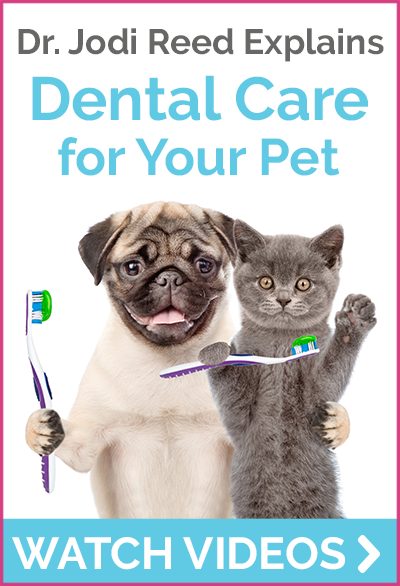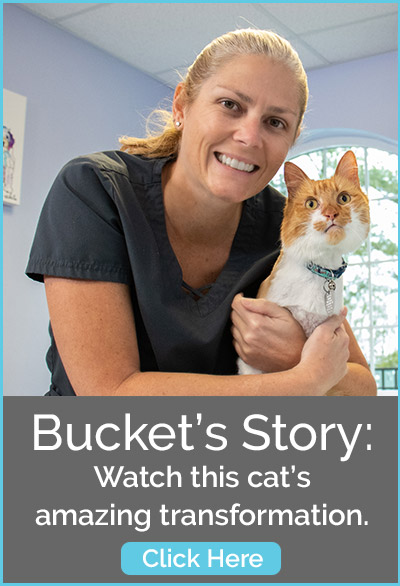Complete Oral Health and Treatment (COHAT)
Despite even the best home care plan to take care of your pet’s teeth, complete oral health and treatment screenings (COHATs), commonly known as cleanings, should always be a regular part of routine pet care. Like in our mouths, animals have plaque, a sticky film of bacteria that builds up within just a few hours of brushing. Plaque hides really well under the gum line, between teeth, and within cracks or natural ridges on the crown’s surface. This is why it is recommended not only to brush your pet’s teeth daily, but why flossing would also greatly benefit teeth that are crowded together. We understand that the reality of brushing their teeth every day is hard for some pet parents (especially cats), but the ability to floss your dog or cat’s teeth may not be comfortable for your pet or safe for your fingers, making regular complete oral health and treatment and other veterinary dental services necessary for your pet’s optimal oral and overall health.
The Problem with Plaque
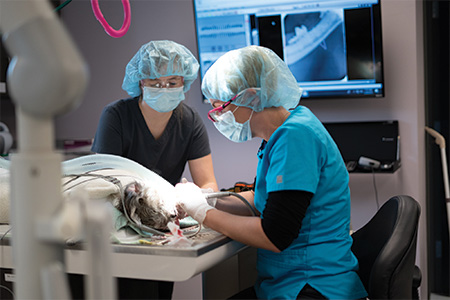
If the tartar is not removed entirely, it will continually build up, leading to gingivitis, inflammation of the gums that causes redness, swelling, and bleeding in your pet’s mouth. This is the mildest form of gum disease, and the good news is this level can be reversed with regular brushing at home and regular COHATs under anesthesia.
Dental Disease
Dental disease is a common problem in cats and dogs, but can often be prevented with a home dental care regimen. Without proper dental care, plaque that forms on the teeth from food particles hardens and forms tartar. This tartar also contains bacteria that migrates between the teeth and gums, causing gingivitis, infection, pain, periodontal disease, and eventually tooth loss. When dental disease is left untreated, bacteria entering the bloodstream through the gums can damage the heart, liver, and kidneys. The best treatment for dental disease is preventative: regular home care, dental exams, and cleanings with your veterinarian as needed.
There are many home care products available for pets. These include pet toothpaste and toothbrushes, dental chews, oral rinses, dental sealants, water additives, and dental diets. At Harmony Animal Hospital, our staff will work with you to formulate a plan tailored to you and your pet.
Developing Periodontal Disease
Once gingivitis develops and if left untreated, it will eventually lead to periodontal disease, a serious disease resulting in significant damage to the soft tissue and bone supporting the teeth. In periodontitis, the inflamed gums begin to pull away from the teeth and form spaces called periodontal pockets that trap even more plaque, tartar, food particles, and bacteria. The body’s immune system fights the bacteria as the plaque spreads and grows below the gum line. Toxins are released from bacteria, and the body’s natural response to infection begins to break down the bone and connective tissue that hold teeth in place. If not treated promptly, the bones, gums, and tissue that support the teeth are destroyed beyond repair. In the worst cases, your pet’s teeth will begin to fall out on their own, which is a slow, very painful process, or will progress to the point that all severely diseased teeth must be surgically extracted.
Impact on Overall Health
Animals with untreated periodontal disease suffer from chronic oral pain and infection and are at a higher risk of developing heart, kidney, and lung problems. This is especially true as pets age, since periodontal disease is a progressive process that happens over time. A visit to our dog dentist can make a world of difference to your pet’s health, and for those concerned, the cost of dog COHATs is not prohibitive. The longer the interval between brushing and COHATs, the more likely we will find problems during your pet’s oral exam. Regular COHAT is incredibly important, and cat and dog tooth care is an essential responsibility of pet ownership.
Benefits and Risks
Middle-aged and senior pets also require complete oral health and treatment screenings under anesthesia on a regular basis. We will always discuss the risks versus the benefits of anesthesia in any patient, but it is a huge misconception that older pets cannot tolerate anesthesia. That is just not true. Here at Harmony Animal Hospital, we have a special interest in senior pet dentistry (ages 10 to 20 years old) and have seen the exceptional benefits to their quality of life and longevity through dental care. Remember that age is not a disease, but dental inflammation, infection, and pain are!
Routine Oral Exams
Depending on how cooperative your pet is, your vet should be able to do a basic oral exam during a routine visit. This is done by lifting your pet’s lip and possibly gently opening the mouth to examine all the teeth. This type of oral exam may be enough to show that your pet has gingivitis, plaque, and tartar and can help determine if your pet requires a COHAT. Other common oral problems, such as a broken tooth, loose teeth, oral tumors, and resorptive lesions, can also be discovered this way. However, if your pet is uncooperative, painful, or aggressive, even this exam may not be possible without sedation or anesthesia.
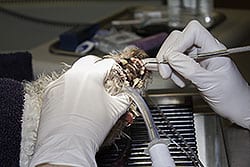
Exams Under Anesthesia
Oral exams under anesthesia also allow for the detection of oral tumors, give us the ability to perform dental radiographs to assess the teeth under the gum line, and make it possible to treat problems if abnormalities are found during the exam. We make every attempt to perform all necessary therapies during the procedure to minimize your pet’s discomfort, reduce costs to you, and avoid having to bring your pet back for a separate anesthetic procedure.
Another benefit of administering anesthesia for COHATs is that passing an endotracheal tube to administer oxygen and inhaled anesthesia protects the patient’s airway. There is a lot of water involved with cleaning, plus bacteria are being released with the tartar as it’s being removed, making it possible that water, bacteria, and chunks of tartar can be aspirated into the lungs if the airway isn’t protected. This can lead to pneumonia and serious respiratory infections.
Complete Oral Health and Treatment (COHAT)
Steps to a professional cleaning under anesthesia:
- A COHAT is performed using an ultrasonic scaler and hand instruments to remove all of the plaque and accumulated tartar above and below the gum line, out of the grooves within the crown of the tooth, and from all areas between teeth. We use disclosing solution afterward to ensure that all plaque and tartar have been properly removed.
- During the cleaning process, small shallow scratches are etched into the enamel of the tooth from the scaler and instruments. These scratches will attract plaque and make it easier for tartar to accumulate. Therefore it is necessary to polish every tooth after the cleaning to smooth the surface of the crown. Polishing is performed on every patient using a slow-speed handpiece and prophy paste to make the tooth enamel smooth and shiny again.
- Next, a complete oral exam thoroughly evaluates each and every tooth one at a time. This also involves examining the gums, lips, tongue, palate, and throat. A complete oral exam includes probing for and measuring periodontal pockets, looking for abnormalities, including oral masses, loose teeth, abscessed teeth, gingivitis, missing teeth, and much more. Any abnormalities are always charted for future reference as well.
- Radiographs (x-rays), when indicated, are also performed using a digital dental radiograph machine. Full mouth X-rays should ideally be taken during every dental procedure since 60% of the tooth is below the gum, where we cannot see disease. However, x-rays should always be taken when there are any abnormalities found on the oral exam, including the finding of fractured teeth, loose teeth, missing teeth, extra teeth, misshaped teeth, malpositioned (crooked) teeth, resorptive lesions, cavities, deep periodontal pockets, oral masses, swellings, and much more.
- A temporary barrier sealant using Oravet is applied to all the teeth and will last up to two weeks after the cleaning. This is applied to the teeth at the base of the gumline to help prevent plaque buildup. Ideally, you should continue this at home once a week, and we will show you how to do this during your pet’s courtesy two-week post-dental recheck exam.
Risks of Anesthesia
It is important to understand that the risk of anesthesia is real. However, the reality is that serious complications are VERY RARE, and we always take all possible precautions with anesthesia to ensure the safety of your pet:
- Pre-anesthetic blood work is required before the day of the dental procedure to ensure your pet has no obvious underlying metabolic problems that could delay or prohibit anesthesia for your pet.
- A pre-medication injection allows our patient to relax, provides pre-emptive pain relief, and allows us to use lower levels of anesthesia.
Every one of our patients will have an IV catheter placed prior to anesthesia for direct venous access during the procedure so that we can more easily and safely administer medications and IV fluids during the procedure.
We always use the safest, most current anesthetic drugs to minimize reactions, side effects, and complications. Once your pet is induced, an endotracheal tube is gently placed into the airway, and all of our patients are maintained on a combination of oxygen and gas anesthesia. Inhaled gas anesthesia allows for easy adjustments to the depth of anesthesia and has the benefit of allowing the patient to breathe pure oxygen and wake up fairly quickly as soon as the gas is turned off.
All patients are thoroughly monitored by a technician and a veterinarian during the entire procedure from start to finish. Our state-of-the-art equipment includes a continuous ECG, heart rate monitor, pulse oxygen saturation (SpO2), blood pressure, capnometer (counts breaths and measures carbon dioxide output), and a digital thermometer. All anesthetized patients’ circulation and body functions are supported with IV fluids, and their body temperature is regulated with an Equator warming blanket.
Our policy and commitment to your pet is that a dedicated veterinarian and technician team stay with each patient from induction of anesthesia through any procedures until they are sitting up, awake, and safe.
In most cases, your pet should be able to go home the same afternoon as the procedure. In rare instances when extensive veterinary dental services such as multiple tooth extractions or large oral tumor removals are performed, we may recommend that your pet stays with us overnight so that we can ensure their pain is adequately controlled, to be able to monitor for swelling or bleeding, and that they are fully recovered from anesthesia and able to go home safely.
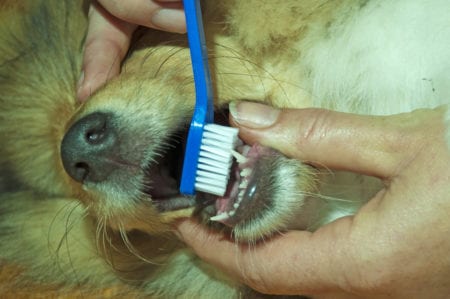
The 411 on
Brushing Your
Pet’s Teeth
It is never too early to start brushing your pet’s teeth. In fact, the younger they are, the better. Tooth brushing should be a bonding experience between you and your pet, constantly reinforced with praise and rewards.
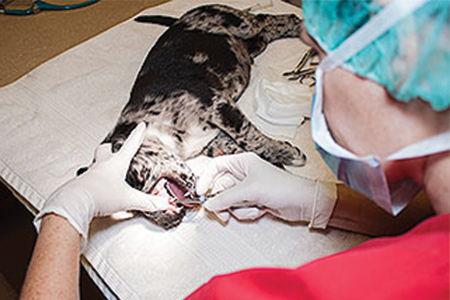
Deciduous
(Baby Teeth) Pet
Tooth Extraction
Dogs and cats, just like humans, lose all of their baby teeth as they grow up. Technically known as deciduous teeth, these baby teeth usually fall out on their own between the ages of three and six months.
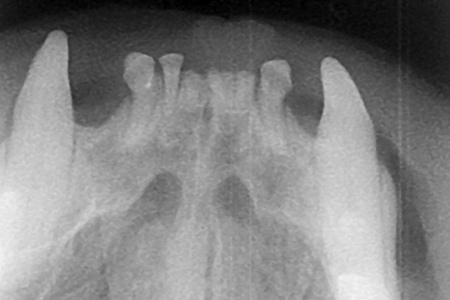
Making the Case
for Dental
Radiographs
With the combination of the oral exam and the dental radiographs, your veterinarian gets a complete picture of your pet’s oral health. This allows us to identify and assess any abnormalities and make appropriate recommendations for the well-being and care of your pet’s oral health.
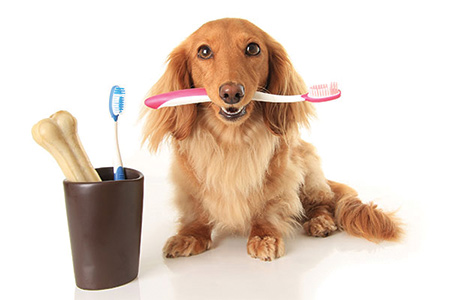
Pet Broken
Tooth
Restoration
Sometimes, during a routine examination, we may notice a fractured (broken) tooth or a cavity. Left untreated, fractured or decaying teeth will lead to oral pain and tooth root infections, so they will always require treatment dependent on the severity of the fracture or cavity.




